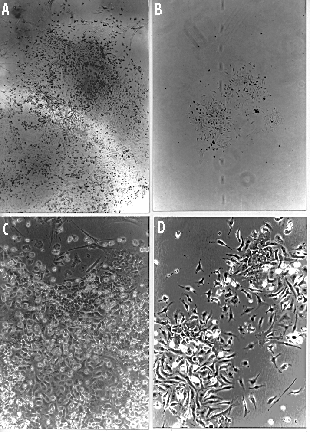


The common practice of radically diluting serum in cell culture has the undesirable side effect of depleting peptidyl hormones that often stabilize the very cells that are being studied. Concentrations of peptidyl hormones in cell culture that are only 10% of normal levels are common and levels 0.5% that of serum are not uncommon. This phenomena can be overcome to some extent by including vitalethine in the cell culture medium. Vitalethine prevents the loss of the progenitor capacity for erythroid (red blood) cells in culture when they are temporarily deprived of their specific peptidyl hormone, erythropoietin. Vitalethine also stabilizes the numbers and morphology of explants of cells from murine splenocytes (Panel A, C, E, G, I, and K) compared with control cultures lacking vitalethine (Panel B, D, F, H, J, and L). Note that the cells are not transformed by vitalethine since they reach very similar endpoints by day 53 (Panel K and L). Preservation of cell numbers with vitalethine is made obvious by comparisons of Panel A (4X) and Panel B (4X) at day 20 of culture. Higher magnifications for this time point in Panel C (10X), D (10X), E (20X), F (20X), G (40X), and H (40X) indicate the striking differences in the differentiated morphologies of cultures in the presence of vitalethine compared with those in its absence. Note the greater presence of vacuoles in the cytoplasm of cells cultured in the absence of vitalethine (Panels F and H). (Click on each sheet of four panels to load larger, high-resolution versions of the following preview panels---700,000 to 800,000 bytes / group of 4 panels or about 5 minutes / sheet).
Vitalethine (Panel I, 10X) is able to preserve cell number and some morphology (Panel J, 10X) for about a month (day 30), but by day 53 (K and L, 10X) differences in morphologies and number of cells in the two cultures decline markedly. Still, the dramatic stabilization of diverse morphologies of cells in culture for about a month represents a distinct advantage for growing and studying cells in more highly-defined media and for growing cells that are inherently more difficult to culture, such as erythroid progenitors and splenocytes.
This preservation of cells in culture does not seem to be the result of increased proliferation since thymidine incorporation into immunocytes taken from mice treated with vitalethine is unchanged or decreased. Because of this, it is more likely that vitalethine prevents losses in the several of the cell morphologies present in fresh explants of murine splenocytes.
GO TO:
| Home | Overview | People | Journal | Nutrition |
| Environment |
|
WWW Links | Outline | e-mail us |